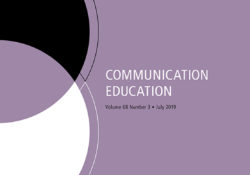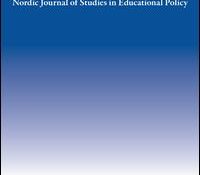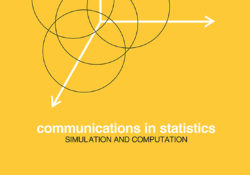eric.ed.gov har udgivet: The Kansas Association of School Boards (KASB) Comparing Kansas report data provides information related to the Kansas State Board of Education’s Kansans Can outcomes and the “Rose Capacities” identified by the Kansas Supreme Court as a standard of constitutional funding and adopted as educational goals by the Kansas Legislature. It also allows Kansas educational performance, funding, and other factors to be compared to other states. This is the second year KASB has produced this report using the same data elements and calculations. For each state, this report offers education performance information on 15 indicators in the following areas: (1) Postsecondary–high school completion or higher, some college or higher, and four-year degree or higher; (2) Graduation–adjusted cohort graduation rate for: all students, economically disadvantaged students, students with limited… Continue Reading →
Like this:
Like Loading...
tandfonline.com har udgivet en rapport under søgningen “Teacher Education Mathematics”: Exploring social work students’ attitudes toward research courses: comparing students in Australia and Switzerland Link til kilde
Like this:
Like Loading...
eric.ed.gov har udgivet: Kansas ranks 10th in the nation on an average of 15 indicators of student success, but has been improving much slower than most states. Since 2008, total funding per pupil in Kansas has increased less than half as much as the U.S. average, and less than one-quarter as much as the top achieving states. “There is growing evidence that as Kansas has fallen behind in educational funding, we are also falling behind in student success outcomes,” said Mark Tallman, assistant executive director of the Kansas Association of School Boards. “We are in danger of falling from a top achieving state to average or worse.” The full 2017 Comparing Kansas report contains detailed information on 15 indicators of student educational success and how they align with the “Rose… Continue Reading →
Like this:
Like Loading...
tandfonline.com har udgivet en rapport under søgningen “Teacher Education Mathematics”: ABSTRACT ABSTRACT The definition for special education needs (SEN) and the policies for its assessment varies widely between countries. This paper aims to investigate similarities and differences through a Swedish-German comparative approach. Based on the distinction between categorical and relational perspectives as expressions of specific thought styles, 58 SEN assessment reports from both countries were qualitatively analysed. The results demonstrate the maintenance of the categorical perspective in terms of focusing on the pupil’s ‘failure’. This result is even more notable in the German examples than the Swedish cases. Exceptionally and in both countries, a relational perspective emerges, taking teaching and the social environment into account. In conclusion, we suggest a flexible SEN approach with a stronger emphasis on the relation… Continue Reading →
Like this:
Like Loading...
eric.ed.gov har udgivet: The study investigated whether online professional development courses with different levels of support have different impacts on teacher outcomes. Variations of an online course for middle school algebra teachers were created for four experimental conditions. One was a highly supported condition, with a math education instructor, an online facilitator, and asynchronous peer interactions among participants available as participants worked through the course together. Another was a self-paced condition, in which none of the supports were available. The other two conditions provided intermediate levels of support. All conditions showed significant impact on teachers’ mathematical understanding, pedagogical beliefs, and instructional practices. Surprisingly, the positive outcomes were comparable across all four conditions. Further research is needed to determine whether this fending is limited to self-selected teachers, the specifics of this… Continue Reading →
Like this:
Like Loading...

tandfonline.com har udgivet en rapport under søgningen “Teacher Education Mathematics”: ABSTRACT ABSTRACT We assessed the effectiveness of an integrated engineering public-speaking class relative to a traditionally taught public-speaking class. The integrated class was designed to meet the growing science, technology, engineering, and mathematics communication needs and the fundamental Accreditation Board for Engineering and Technology and the National Communication Association student outcomes related to public speaking. Working within the Communication in the Disciplines theoretical framework, this study employed a quasi-experiment with both a test (engineering specific communication class) and control (traditional communication class) group; finding a significant increase with respect to attitude toward communication for students before and after the engineering specific class compared with the traditional class. Along with attitude toward communication, efficacy toward communication and being enrolled in the… Continue Reading →
Like this:
Like Loading...
eric.ed.gov har udgivet: This study investigated whether two different versions of an online professional development course produced different impacts on the intended outcomes of the course. Variations of an online course for middle school algebra teachers were created for two experimental conditions. One was an actively facilitated course with asynchronous peer interactions among participants. The second was a self-paced condition, in which neither active facilitation nor peer interactions were available. Both conditions showed significant impact on teachers’ mathematical understanding, pedagogical beliefs, and instructional practices. Surprisingly, the positive outcomes were comparable for both conditions. Further research is needed to determine whether this finding is limited to self-selected teachers, the specifics of this online course, or other factors that limit generalizability. (Contains 6 tables.) Link til kilde
Like this:
Like Loading...

tandfonline.com har udgivet en rapport under søgningen “Teacher Education Mathematics”: ABSTRACT ABSTRACT Poor performance in international student assessment has led to calls to enhance evidence-based practice in the German educational system. Yet indications about the extent to which German practitioners use data is limited, and little is known about factors influencing data-driven school improvement. Using data from three studies and comparing schools in different circumstances, we examined the perceived usefulness and the application of 13 different sources of information that can inform teachers’ and school leaders’ practice by means of standardised questionnaires. The results showed that practitioners attributed little usefulness to a standards-based reform and consequently hardly used these data. Instead, they claimed to prefer process-oriented information sources, such as student feedback. A comparison of the different samples indicated that… Continue Reading →
Like this:
Like Loading...
tandfonline.com har udgivet en rapport under søgningen “Teacher Education Mathematics”: ABSTRACT ABSTRACT Two classes of methods properly account for clustering of data: design-based methods and model-based methods. Estimates from both methods have been shown to be approximately equal with large samples. However, both classes are known to produce biased standard error estimates with small samples. This paper compares the bias of standard errors and statistical power of marginal effects for generalized estimating equations (a design-based method) and generalized/linear mixed effects models (model-based methods) with small sample sizes via a simulation study. Provided that the distributional assumptions are met, model-based methods produced the least-biased standard error estimates and greater relative statistical power. Link til kilde
Like this:
Like Loading...
tandfonline.com har udgivet en rapport under søgningen “Teacher Education Mathematics”: ABSTRACT Formulae display:?Mathematical formulae have been encoded as MathML and are displayed in this HTML version using MathJax in order to improve their display. Uncheck the box to turn MathJax off. This feature requires Javascript. Click on a formula to zoom. ABSTRACT The aim of this paper is to investigate and compare lessons given in primary school teacher education in Japan, Finland and Sweden. We analyse one lesson from each country and compare them using a common framework. Chevallard’s anthropological theory of the didactic (ATD) is used to frame this analysis and in particular to model teacher educators’ didactic organization of the lessons. The focus is on how the didactic organizations of the teacher educators relate to the mathematical and… Continue Reading →
Like this:
Like Loading...





